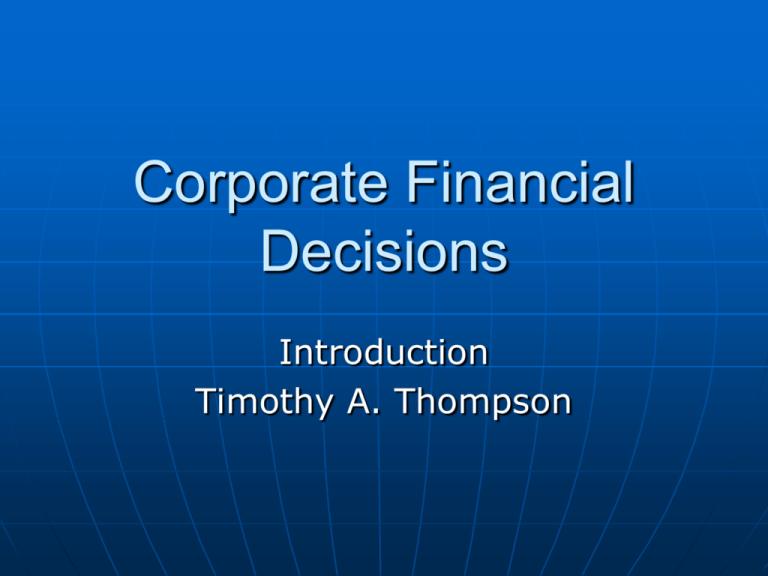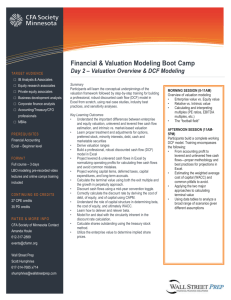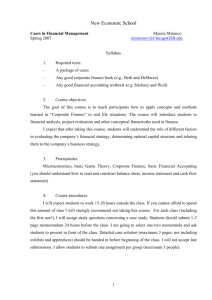Corporate Financial Decisions - Kellogg School of Management
advertisement

Corporate Financial Decisions Introduction Timothy A. Thompson Goal of the Course • Application of Financial Principles to Strategic Decision Making Principles of Finance • Valuation Discounted cash flow (DCF) Option valuation • Risk and return models Capital asset pricing model (CAPM) • Capital structure theory Tradeoff theory/pecking order hypothesis • Risk management Valuation What is the valuation principle? • Value of an asset (security, strategy, firm, etc.) is the present value all the future cash flows (expected) deriving to the owners of the asset discounted at a rate of return (expected) commensurate with the riskiness of the future cash flows What are strategic corporate decisions? What investments should firm make? • Capital budgeting Identity of the firm • Should firm conglomerate or focus? Growth vs. harvesting • Grow via acquisitions vs. internal growth Financing policy • Target debt/equity policy • Internal/external equity • How to finance current plans? What does “value” have to do with strategic decision-making? Should corporate decisions pursued with a goal of maximizing shareholder value? • If so, we need to know how to calculate SHV and how to assess the impact of our strategic decisions on SHV. What about other constituencies? Employees Communities Unions Management Board of directors We need to understand SHV Stakeholders framework • Even if decisions are made to weigh the interests of different groups, we need to be able to value alternative courses of action from the perspective of shareholders Shareholder influence • Hostile acquisitions relatively rare, but • Shareholder proxies, activist institutional holders, etc. Is shareholder value the same as stock price? If markets are strong form efficient, yes. Are markets strong form efficent? No. Corporate insiders often have important information about strategy, etc., that market doesn’t have. Maybe not. Sometimes it looks like the market is really out to lunch (e.g., Internet stocks). Sooner or later, stock price is arbiter. But how soon? Valuation and risk Probability E(CFt) CFt DCF and risk We discount expected cash flows • Not pessimistic, not optimistic • Expected cash flows weigh all the possibilities by their respective probabilities (total risk) Discount these at a discount rate that is appropriate for the risk of the cash flows • V0 = E(CFt)/(1+ri)t Matching principle: match the discount rate to the riskiness of the cash flow Capital asset pricing model CAPM asserts that the discount rate should be based only on systematic risk • Non-diversifiable, general economic risk • Measured by beta • Not total risk, because much of the “risk” of the cash flows can be diversified away ri = rf + ßi (rm – rf ) Certainty equivalent method DCF assumes that the “riskier” a future cash flow is the higher the discount rate should be applied to the “expected value” of the future cash flow. Alternatively, we could ask “what cash flow received with certainty at time t would make you indifferent between that certain cash flow and the risky CFt?” Call the certainty equivalent cash flow CECFt and discount it at rf. Which is better? In theoretical models typically applied (e.g., CAPM) they are equivalent DCF for project/firm valuation typically uses the first method (expected cash flows and a riskadjusted discount rate) Option pricing, in contrast, uses the certainty equivalent method Capital structure and valuation What is the impact of capital structure on valuation? • No impact? (Modigliani-Miller, 1958) • Interest expenses are tax deductible to the corporation, whereas payments to equity are not We can calculate the value of tax shields of debt policy • Higher debt leads to greater expected costs of financial distress Difficult to estimate, but conceptually offset some of benefits of debt such as tax shields Syllabus goals Bed Bath & Beyond Consider pros and cons of using leverage in capital structure Valuation of tax shields of debt in the capital structure • Estimate in dollars: uses Adjusted Present Value Method (define later) Syllabus goals, continued Marriott While BBBY allows us to calculate the value added to the company by use of debt in its capital structure, this is normally not done using APV, but via the weighted average cost of capital (WACC) Nuts and bolts of estimating WACC as the cost of capital John Case Company What cash flows do you use to calculate the enterprise value of a company? What is the difference between DCF valuation of a project and the DCF valuation of a company? Contrast this method to entrepreneurial/venture capital/private equity methods Syllabus goals, continued Pinkerton (A) Valuation in M&A • Multiples: Comparable transactions method • Premiums paid • Discounted cash flow depends on perspective and strategy (Value to the acquirer) Stand alone plus synergy value plus value added/lost due to financing terms Pepsi-Quaker Puts together all the pieces.








